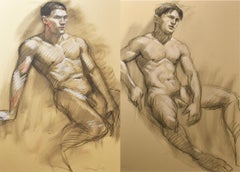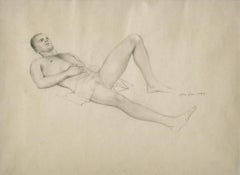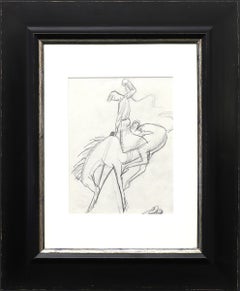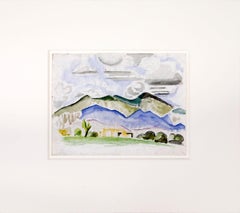Arnold Ronnebeck Drawings and Watercolor Paintings
1885-1947
Modernist sculptor, lithographer and museum administrator, Rönnebeck was a noted member of European and American avant-garde circles in the early twentieth century before settling in Denver, Colorado, in 1926.
After studying architecture at the Royal Art School in Berlin for two years beginning in 1905, he moved to Paris in 1908 to study sculpture with Aristide Maillol and Émile-Antoine Bourdelle. While there he met and befriended American modernist painter, Marsden Hartley, of whom he sculpted a bronze head that was exhibited at the Salon d’Automne in Paris in 1912 and the following year at Hartley’s solo show of paintings at Alfred Stieglitz’s Gallery 291 in New York.
After World War I Rönnebeck traveled in Italy with German writer, Max Sidow, and German poet, Theodor Daubler, doing a series of drawings of Positano and the Amalfi Coast that formed the basis for his lithographs on the subject. The death of his finacée, the young American opera singer Alice Miriam in 1922 and his own family’s increasing financial problems in post-World War I Germany led him to immigrate to the United States in 1923. After living briefly with Miriam’s family in Washington, DC, he moved to New York where he became part of the avant-garde circle around Alfred Stieglitz.
In the summer of 1925, as the guest of Mabel Dodge Luhan, Rönnebeck first saw Taos, New Mexico, which Marsden Hartley had encouraged him to visit. It was there that he met his future wife, Louise Emerson, an easel painter and muralist. A year later they were married in New York before relocating to Denver. He served as director of the Denver Art Museum from 1926 to 1930 where he invited Marsden Hartley to lecture on Cézanne’s art in 1928. Rönnebeck fostered the development of the museum’s collection of American Indian art and the curation of modernist art exhibitions. In addition to his work at the museum, he was professor of sculpture at the University of Denver’s College of Fine and Applied Arts from 1929 to 1935, and wrote a weekly art column in the Rocky Mountain News.
In Colorado, the subject matter of his lithographs became the state’s landscape and its mining towns, as well as Native Americans from the pueblos in neighboring New Mexico. By the early 1930s Colorado’s old mining towns became a popular genre for artists because they were easily accessible, and their architectural components provided a welcome break from the nineteenth-century panoramic landscape tradition and the overwrought cowboy-and-Indian subject matter of the previous generation. As an amateur actor and music enthusiast, Rönnebeck had an additional connection with Central City.
In June 1947, some five months before his death, the Denver Art Museum organized a solo exhibition of his sculptures, watercolors and prints.
© copyright Stan Cuba for David Cook Galleriesto
1
Overall Width
to
Overall Height
to
1
1
1
1
1
1
1
1
1
1
9
922
406
282
279
1
1
Artist: Arnold Ronnebeck
Arnold Rönnebeck Graphite on Paper Drawing, "I’m a Little Blackbird", ca. 1924
By Arnold Rönnebeck
Located in New York, NY
Arnold Rönnebeck, 1885 – 1947
I’m a Little Blackbird..., c. 1924
Graphite on paper
Estate stamp
Category
1920s Arnold Ronnebeck Drawings and Watercolor Paintings
Materials
Graphite
Related Items
MB 076 A&B (Double Sided Figurative Charcoal Drawing of Male Nudes)
By Mark Beard
Located in Hudson, NY
Figurative drawing of male nudes made with graphite, charcoal, and conte crayon on Arches paper
30 x 22 inches, unframed
One piece of 30 x 22 inch Arches. Two drawings, one on either...
Category
Early 2000s Modern Arnold Ronnebeck Drawings and Watercolor Paintings
Materials
Charcoal, Archival Paper, Graphite
$1,600
H 30 in W 22 in
Resting Man (Man relaxes draped only in a small towel) - In Celebration of Pride
Located in New Orleans, LA
Stone and Press Gallery is excited to offer several works in celebration of the LGBTQ community.
A rare pencil drawing by John Lear created in 1957, signed and dated in pencil.
John Brock Lear...
Category
1930s Academic Arnold Ronnebeck Drawings and Watercolor Paintings
Materials
Pencil, Graphite
$1,120 Sale Price
20% Off
H 10.25 in W 13.25 in
Jeanne-marie Barbey (1876-1960), Trees in Winter, Brown ink wash
Located in PARIS, FR
Jeanne-Marie BARBEY (1876-1960)
Trees in winter
Brown ink wash and graphite pencil on paper
Signed lower right
26 x 20 cm
frame 46 x 40 cm
Born Louise Jeanne Marie Barbée in 1876 in...
Category
Early 20th Century Arnold Ronnebeck Drawings and Watercolor Paintings
Materials
Watercolor, Graphite
$585
H 10.24 in W 7.88 in
" Studio per Ritratto di Lady Anne Simms Reeve of Brancaster Hall " 1870 ca
Located in Torino, IT
Raro studio dell'artista Preraffaellita Frederick Sandys,Studio per l’opera
Portrait of a Lady,( Anne Simms Reeve of Brancaster Hall, Norfolk) proprie...
Category
1870s Pre-Raphaelite Arnold Ronnebeck Drawings and Watercolor Paintings
Materials
Crayon, Graphite
$14,350
H 25.2 in W 20.48 in D 1.58 in
John W. Carmichael (1800-1868) - Graphite Drawing, Mussel Pickers on the Shore
By John Wilson Carmichael
Located in Corsham, GB
Initialled and dated lower right. Artist's name and dates inscribed verso by a later hand. Presented in a narrow wooden frame. On primed paper.
Category
Mid-19th Century Arnold Ronnebeck Drawings and Watercolor Paintings
Materials
Graphite
$271 Sale Price
20% Off
H 11.82 in W 13.19 in
Study for Assumption of the Virgin
Located in Middletown, NY
Graphite on hand made, fibrous wove paper, finished with gray wash. Unevenly trimmed sheet edges, non-archival tape remnants at all four corners, recto, well outside of image area. Horseshoe-shaped area of light discoloration that extends significantly into the figure's face, beneath the lips, and up over the rear of the head, dog-eared right lower corner with associated light discoloration at crease. DeMin and Belluno inscribed in graphite, verso.
A detailed study showing 'primo pensiero' for Giovanni DeMin's large scale fresco, Assumption of the Virgin...
Category
Mid-19th Century Old Masters Arnold Ronnebeck Drawings and Watercolor Paintings
Materials
Handmade Paper, Graphite
The Dethroning / Italian School, 18th Century
Located in Middletown, NY
Graphite and grayish ink wash on bluish wove paper, 7 x 10 1/2 inches (177 x 265 mm) (matrix). Scattered surface soiling, adhesive residue, dog-eared corners, and scattered edge tears along left margin, outside of image area. Paper is braced on the verso with two pages from a mid 19th century book with illustrations by C.Perrin. One image depicts a scene of a group of soldiers representing the Holy Roman Empire...
Category
Late 18th Century Italian School Arnold Ronnebeck Drawings and Watercolor Paintings
Materials
Handmade Paper, Ink, Graphite
At Tunbridge Well
By Agostino Aglio
Located in Middletown, NY
Black crayon and graphite with white heightening on blue handmade laid paper. Adhered at all four corners to a period support, on which the title and an illegible date (perhaps 1815) appear to be written in the artist's hand.
________
Aglio was born in Cremona is 1777 and his artistic talent was recognized early in his life. He was promised a place at the University in Milan by the Holy Roman Emperor, however, his formal education was upended before it even began by the invasion of Italy and Austria by Napoleon. Aglio joined the war effort and fought in a series of major battles near Venice before becoming seriously ill. At the age of about 23 he was released from duty, and traveled to Rome to focus on his health, and landscape painting. In Rome, Aglio studied with the renowned artist Campovecchio. At the invitation of well known British architect William Wilkins (designer of the National Gallery and University College London), Aglio relocated to London in 1803. He made London his permanent home, and married Letitia Clarke in 1805. He enjoyed a lucrative career painting frescoes in the interiors of high society townhouses, country manors, and major London concert halls and theaters. Most notably, Aglio painted multiple official portraits of Queen Victoria...
Category
Early 19th Century Old Masters Arnold Ronnebeck Drawings and Watercolor Paintings
Materials
Crayon, Handmade Paper, Laid Paper, Color Pencil, Graphite
Rue de Thorigny, signed F. Feuilloy
Located in Middletown, NY
Graphite and crayon in color with white heightening on cream wove paper, 13 1/2 x 12 1/4 inches (343 x 310 mm) (sheet). In good condition with uniform toning, handling creases, and lightly dog-eared corners.
The building on the left is a hotel particulier in Paris' Marais neighborhood, the Hôtel Salé, which now houses the Musée Picasso.
Category
Late 19th Century French School Arnold Ronnebeck Drawings and Watercolor Paintings
Materials
Crayon, Graphite, Handmade Paper
Cottages in Devon
By Samuel Prout
Located in Middletown, NY
An early Devonshire landscape, ex-collection West Collection of British Watercolors & the Fine Art Society, London.
Circa 1800
Ink and brown wash on paper, 7 1/8 x 10 1/4 inches (...
Category
Early 1800s Realist Arnold Ronnebeck Drawings and Watercolor Paintings
Materials
Watercolor, Ink, Graphite
Portrait of Raffaello / Italian School
Located in Middletown, NY
Graphite and ink on handmade, watermarked C & I Honig laid paper, 8 15/16 x 6 3/4 inches (226 x 170 mm). Signed illegibly in ink, lower margin. Scattered light creasing and surface...
Category
18th Century Italian School Arnold Ronnebeck Drawings and Watercolor Paintings
Materials
Handmade Paper, Ink, Graphite
Study of a Sleeping Girl in a Cap
By Jean-Baptiste Greuze
Located in Middletown, NY
Graphite on greenish gray wove paper. 15 1/4 x 11 5/8 inches (390 x 295 mm). Initialed "G. B." in pencil on the lower right recto. In generally good condition with some minor scattered surface soiling. Condition is consistent with age.
____
This drawing is closely related to two known mid 18th century oils...
Category
18th Century Old Masters Arnold Ronnebeck Drawings and Watercolor Paintings
Materials
Handmade Paper, Graphite
Previously Available Items
Bucking Bronco, Original Sketch of Horse and Cowboy, Modernist Framed Drawing
By Arnold Rönnebeck
Located in Denver, CO
Graphite on paper drawing by Arnold Ronnebeck of a bucking bronco and cowboy, signed by the artist in the lower right corner. Presented in a custom black frame, outer dimensions measure 22 ⅜ x 18 ⅜ x ¾ inches. Image sight size is 10 ½ x 8 ¾ inches.
Drawing is clean and in very good vintage condition - please contact us for a detailed condition report.
Expedited and international shipping is available - please contact us for a quote.
About the artist:
Modernist sculptor, lithographer and museum administrator, Rönnebeck was a noted member of European and American avant-garde circles in the early twentieth century before settling in Denver, Colorado, in 1926.
After studying architecture at the Royal Art School in Berlin for two years beginning in 1905, he moved to Paris in 1908 to study sculpture with Aristide Maillol and Émile-Antoine Bourdelle. While there he met and befriended American modernist painter, Marsden Hartley, of whom he sculpted a bronze head that was exhibited at the Salon d’Automne in Paris in 1912 and the following year at Hartley’s solo show of paintings at Alfred Stieglitz’s Gallery 291 in New York. A frequent guest of Gertrude Stein’s Saturday "evenings" in Paris, she described Rönnebeck as "charming and always invited to dinner," along with Pablo Picasso, Mabel Dodge (Luhan) and Charles Demuth.
After the outbreak of World War I in 1914, Rönnebeck returned to Germany where he served as an officer in the German Imperial Army on the front lines. Twice wounded, including in the Battle of Marne in France, Kaiser Wilhelm II awarded him the Iron Cross. During the war Hartley fell in love with Rönnebeck’s cousin, Lieutenant Karl von Freyburg, who was killed in combat. As a tribute to Freyburg, Hartley created Portrait of a German Officer (1914) now in the Metropolitan Museum of Art in New York.
After the war Rönnebeck traveled in Italy with German writer, Max Sidow, and German poet, Theodor Daubler, doing a series of drawings of Positano and the Amalfi Coast that formed the basis for his lithographs on the subject. The death of his finacée, the young American opera singer Alice Miriam in 1922 and his own family’s increasing financial problems in post-World War I Germany led him to immigrate to the United States in 1923. After living briefly with Miriam’s family in Washington, DC, he moved to New York where he became part of the avant-garde circle around Alfred Stieglitz. His essay, "Through the Eyes of a European Sculptor," appeared in the catalog for the Anderson Gallery exhibition, "Alfred Stieglitz Presents Seven Americans: 159 Paintings, Photographs & Things, Recent & Never Publicly Shown, by Arthur G. Dove, Marsden Hartley, John Marin, Charles Demuth, Paul Strand, Georgia O’Keeffe, Alfred Stieglitz."
In New York Rönnebeck began producing Precisionist-style lithographs of the city’s urban landscapes which he termed "living cubism." Some of them were reproduced in Vanity Fair magazine. Through Stieglitz he met Erhard Weyhe head of the Weyhe Gallery who, with its director Carl Zigrosser, arranged Rönnebeck’s first solo American exhibition in May 1925 at the gallery in New York. Comprising some sixty works – prints, drawings and sculpture – the show subsequently traveled on a thirteen-month tour of major American cities. Until the end of his life, the gallery represented him, along with other American artists Adolf Dehn, Wanda Gag, Rockwell Kent, J.J. Lankes, Louis Lozowick, Reginald Marsh and John Sloan.
In the summer of 1925, as the guest of Mabel Dodge Luhan, Rönnebeck first saw Taos, New Mexico, which Marsden Hartley had encouraged him to visit. It was there that he met his future wife, Louise Emerson, an easel painter and muralist. A year later they were married in New York before relocating to Denver. He served as director of the Denver Art Museum from 1926 to 1930 where he invited Marsden Hartley to lecture on Cézanne’s art in 1928. Rönnebeck fostered the development of the museum’s collection of American Indian art and the curation of modernist art exhibitions. In addition to his work at the museum, he was professor of sculpture at the University of Denver’s College of Fine and Applied Arts from 1929 to 1935, and wrote a weekly art column in the Rocky Mountain News.
His best known Denver sculptures from the late 1920s in bronze, copper, stone, wood and terra cotta include a reredos, The Epiphany, at St. Martin’s Chapel; The History of Money (six panels) at the Denver National Bank; The Ascension at the Church of Ascension; and the William V. Hodges Family Memorial at Fairmount Cemetery. At the same time he did a series of terra cotta relief panels for La Fonda Hotel in Santa Fe, New Mexico. In the 1930s his bas-relief aluminum friezes of stylized Pueblo and Hopi Indian Kachina masks...
Category
20th Century American Modern Arnold Ronnebeck Drawings and Watercolor Paintings
Materials
Graphite
H 22.5 in W 18.5 in D 0.75 in
Summer Afternoon, Taos, New Mexico, 1920s Modern Watercolor Mountain Landscape
By Arnold Rönnebeck
Located in Denver, CO
Watercolor on paper. Image size is 7 ¾ x 10 ¼ inches, dimensions with mat measure 16 ¼ x 18 ¼ inches. This piece is unframed, housed in an archival mat. Framed pictures are mock-ups and custom framing options are available.
Painting is clean and in very good vintage condition - please contact us for a complete condition report.
Expedited and international shipping is available - please contact us for a quote.
Provenance: Estate of Arnold Ronnebeck
About the artist:
Modernist sculptor, lithographer and museum administrator, Rönnebeck was a noted member of European and American avant-garde circles in the early twentieth century before settling in Denver, Colorado, in 1926.
After studying architecture at the Royal Art School in Berlin for two years beginning in 1905, he moved to Paris in 1908 to study sculpture with Aristide Maillol and Émile-Antoine Bourdelle. While there he met and befriended American modernist painter, Marsden Hartley, of whom he sculpted a bronze head that was exhibited at the Salon d’Automne in Paris in 1912 and the following year at Hartley’s solo show of paintings at Alfred Stieglitz’s Gallery 291 in New York. A frequent guest of Gertrude Stein’s Saturday "evenings" in Paris, she described Rönnebeck as "charming and always invited to dinner," along with Pablo Picasso, Mabel Dodge (Luhan) and Charles Demuth.
After the outbreak of World War I in 1914, Rönnebeck returned to Germany where he served as an officer in the German Imperial Army on the front lines. Twice wounded, including in the Battle of Marne in France, Kaiser Wilhelm II awarded him the Iron Cross. During the war Hartley fell in love with Rönnebeck’s cousin, Lieutenant Karl von Freyburg, who was killed in combat. As a tribute to Freyburg, Hartley created Portrait of a German Officer (1914) now in the Metropolitan Museum of Art in New York.
After the war Rönnebeck traveled in Italy with German writer, Max Sidow, and German poet, Theodor Daubler, doing a series of drawings of Positano and the Amalfi Coast that formed the basis for his lithographs on the subject. The death of his finacée, the young American opera singer Alice Miriam in 1922 and his own family’s increasing financial problems in post-World War I Germany led him to immigrate to the United States in 1923. After living briefly with Miriam’s family in Washington, DC, he moved to New York where he became part of the avant-garde circle around Alfred Stieglitz. His essay, "Through the Eyes of a European Sculptor," appeared in the catalog for the Anderson Gallery exhibition, "Alfred Stieglitz Presents Seven Americans: 159 Paintings, Photographs & Things, Recent & Never Publicly Shown, by Arthur G. Dove, Marsden Hartley, John Marin, Charles Demuth, Paul Strand, Georgia O’Keeffe, Alfred Stieglitz."
In New York Rönnebeck began producing Precisionist-style lithographs of the city’s urban landscapes which he termed "living cubism." Some of them were reproduced in Vanity Fair magazine. Through Stieglitz he met Erhard Weyhe head of the Weyhe Gallery who, with its director Carl Zigrosser, arranged Rönnebeck’s first solo American exhibition in May 1925 at the gallery in New York. Comprising some sixty works – prints, drawings and sculpture – the show subsequently traveled on a thirteen-month tour of major American cities. Until the end of his life, the gallery represented him, along with other American artists Adolf Dehn, Wanda Gag, Rockwell Kent, J.J. Lankes, Louis Lozowick, Reginald Marsh and John Sloan.
In the summer of 1925, as the guest of Mabel Dodge Luhan, Rönnebeck first saw Taos, New Mexico, which Marsden Hartley had encouraged him to visit. It was there that he met his future wife, Louise Emerson, an easel painter and muralist. A year later they were married in New York before relocating to Denver. He served as director of the Denver Art Museum from 1926 to 1930 where he invited Marsden Hartley to lecture on Cézanne’s art in 1928. Rönnebeck fostered the development of the museum’s collection of American Indian art and the curation of modernist art exhibitions. In addition to his work at the museum, he was professor of sculpture at the University of Denver’s College of Fine and Applied Arts from 1929 to 1935, and wrote a weekly art column in the Rocky Mountain News.
His best known Denver sculptures from the late 1920s in bronze, copper, stone, wood and terra cotta include a reredos, The Epiphany, at St. Martin’s Chapel; The History of Money (six panels) at the Denver National Bank; The Ascension at the Church of Ascension; and the William V. Hodges Family Memorial at Fairmount Cemetery. At the same time he did a series of terra cotta relief panels for La Fonda Hotel in Santa Fe, New Mexico. In the 1930s his bas-relief aluminum friezes of stylized Pueblo and Hopi Indian Kachina masks...
Category
1920s American Modern Arnold Ronnebeck Drawings and Watercolor Paintings
Materials
Watercolor
Casa Luhan, Adobe Home of Mabel Dodge Luhan, Taos, New Mexico, Landscape
By Arnold Rönnebeck
Located in Denver, CO
Casa Luhan (Home of Mabel Dodge Luhan, Taos, New Mexico) vintage 1925 modernist original drawing by Arnold Ronnebeck (1885-1947), southwestern landsc...
Category
1920s American Modern Arnold Ronnebeck Drawings and Watercolor Paintings
Materials
Graphite
H 19.5 in W 23.5 in D 0.5 in
Arnold Ronnebeck drawings and watercolor paintings for sale on 1stDibs.
Find a wide variety of authentic Arnold Ronnebeck drawings and watercolor paintings available for sale on 1stDibs. You can also browse by medium to find art by Arnold Ronnebeck in graphite, pencil and more. Not every interior allows for large Arnold Ronnebeck drawings and watercolor paintings, so small editions measuring 9 inches across are available. Customers who are interested in this artist might also find the work of Hugó Scheiber, Frank Wilcox, and Martha Walter. Arnold Ronnebeck drawings and watercolor paintings prices can differ depending upon medium, time period and other attributes. On 1stDibs, the price for these items starts at $28,000 and tops out at $28,000, while the average work can sell for $28,000.




